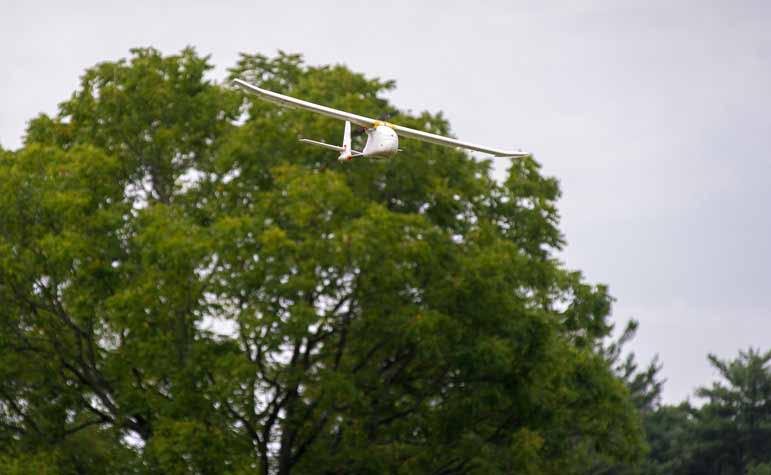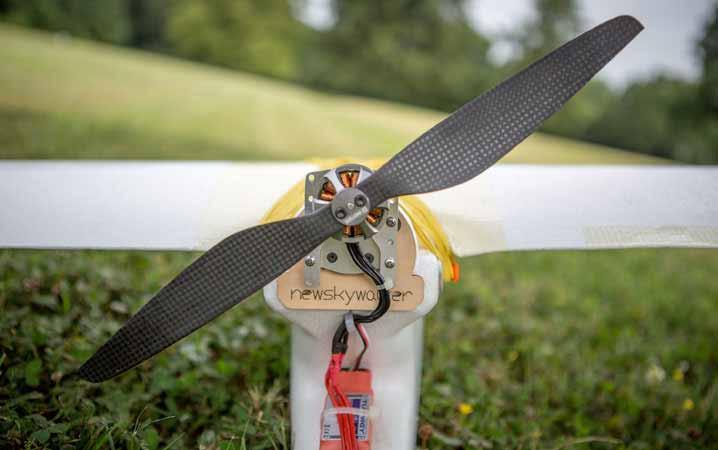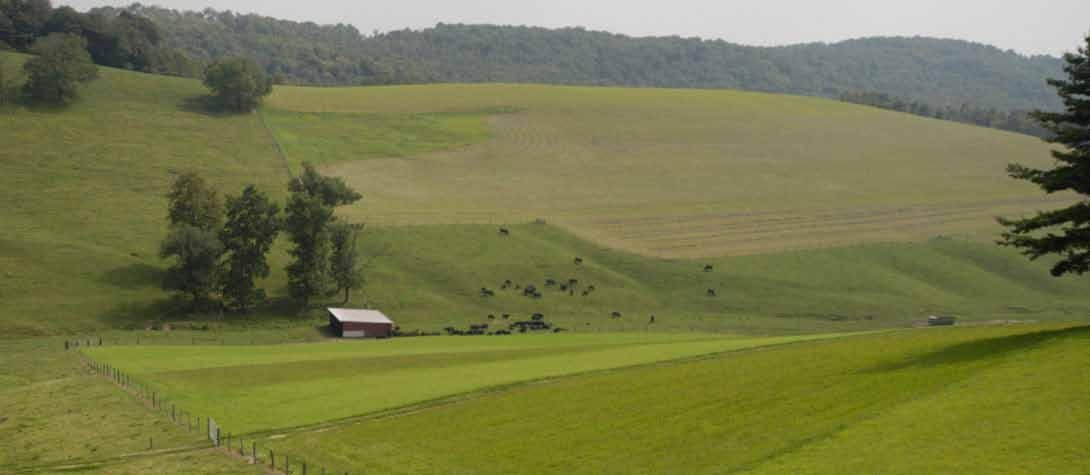
FS-998 | November 2015
Privacy Issues and the Use of sUAS/Drones in Maryland
According to the Federal Aviation Administration (FAA), the lawful use of Unmanned Aerial Vehicles (UAV), also known as Unmanned Aircraft Systems (UAS), or more commonly as drones, are currently limited to military, research, and recreational applications. Under the FAA’s view, commercial uses of drones are illegal unless approved by the Federal government. This will change in the future. Congress authorized the FAA to develop regulations for the use of drones by private parties in the U.S by September 30, 2015 (FAA Modernization Act of 2012). FAA missed this deadline, but expects comprehensive regulations for drones to be completed by June 2016 (Jansen, 2015).

History shows that the law rarely keeps up with technology. Courts often struggle when applying existing laws and previous rulings to modern technology. State legislatures can help clearly define some of the rules to guide courts in how to handle new technology. Drones have the potential to benefit producers (through crop and livestock monitoring), but they present new challenges as other groups begin to use the technology.
Drones have the potential to benefit producers through crop and livestock monitoring, but present challenges as other groups begin to use the technology.
Companies Already Seeing Potential Benefit of Drones
In 2014, Amazon CEO Jeff Bezos discussed on the television show 60 Minutes how Amazon is looking to drones to deliver purchases. United Parcel Service also sees a future in package delivery using drones (Stern, 2013). The FAA recently granted San Diego Gas & Electric (SDG&E) permission to use drones for research and testing. SDG&E plans to test the drones for inspecting power and gas lines in areas that are off-limits to helicopters and difficult to access by roads (McNeal, 2014).

Drones also have potential uses in agriculture (Green, 2013). A corn or soybean producer could use drones to monitor a field, checking for insects, disease, and other pests more efficiently than with traditional scouting methods. Drones also can be used to monitor irrigation effectiveness or assist in gathering precise data for prescriptive planting. Livestock producers could check their stock more efficiently. Drones could provide producers with better information on crop/livestock conditions and allow them to quickly react to an outbreak before it is too late. Producers using a drone with a heat sensor could detect hot spots in fields and quickly treat disease before the crop is lost.
Federal Approval of Unmanned Aircraft is Limited
To date, the FAA has approved only use of recreational unmanned aircraft, such as model airplanes, at altitudes below 400 feet (Unmanned Aircraft (UAS) General FAQs, 2014). Non-recreational users are required to get FAA approval before using drones (Nicas and Pasztor, 2014). It is uncertain whether an agricultural producer using a drone on the farm is considered a commercial use (Doering, 2014). It is equally uncertain whether drones could be used by private groups such as environmental groups to monitor agricultural operations without first seeking FAA approval.
The FAA does not regulate drones considered “model aircraft” (§ 336(a) 2012 FAA Reauthorization Act). A drone is deemed a model aircraft if it weighs less than 55 pounds and is operated in compliance within certain safety guidelines, which include flying within the operator’s line-of-sight and below 400 feet. The owner also must provide prior notice to air traffic control operators if flying within 5 miles of an airport. Another critical requirement of the definition of model aircraft is that it must be “flown strictly for hobby or recreational use” (§ 336(a)).

Most drones used, or considered for use for agricultural applications are small, weigh less than 55 pounds, and are intended for flight below 400 feet. However, using these drones for agricultural applications disqualifies them from consideration as model aircraft because they are flown for a commercial purpose. In January 2015, FAA granted a regulatory exemption for a Washington-state company to use a drone for crop scouting in precision ag. As of publication, this is one of the only exemptions granted by FAA for agriculture (FAA, 2015). While FAA has multiple guidance documents declaring that the commercial use of drones is unlawful, the agency has not yet actually promulgated regulations to that effect.
Use of Drones Will Spark Privacy Concerns
A common statement in discussions of drone use is, “well, if we can use a drone then that means (fill in the blank) group can use drones to monitor us.” Animal rights groups already have said they plan to use drones to monitor farms for cruelty to animals (Lee, 2013). Agricultural producers also worry that environmental groups will use drones to monitor their operations.
Privacy issues will only increase once FAA approves all commercial drone use. Producers undoubtedly will be concerned about the ability of government entities or environmental or animal rights groups to use photographs and other evidence gathered from drones flying over farms. As a result, there are areas of law that may need to change to provide property owners (farmer or non-farmer) privacy protections from drones.
Privacy issues will only increase once FAA approves all commercial drone use.
Can I Limit Unwanted Drones From Flying Over My Property?
Some property owners have asked if they can shoot down drones flying over their property. The answer to that question is simple: No, destruction of drones is not allowed. However, there are potentially two existing legal theories which may help protect a property owner’s privacy: 1) trespass and 2) nuisance.
Trespass Is Entering an Owner’s Property Without Permission.

Under common law theories of property ownership, you own land “from the center of the earth to the heavens.” But as the use of airplanes became more prevalent in the mid-20th century, courts have severely limited the idea of owning land skywards. As a property owner, you have no right to exclude aircraft from flying over your property because that airspace is considered part of the public domain (Md. Code, Transp. § 5-1001 (LexisNexis 2014)).
At this point, it is unclear how a court would apply a claim of trespass to an unwanted drone flying over your property. Maryland courts have never dealt directly with the issue of an aircraft committing trespass. Courts in other states have found that aircraft can trespass (Schronk, 1964). Courts in those states have ruled that an aircraft can commit trespass only if “it enters into the immediate reaches of the air space next to the land,” and needs to substantially interfere with the owner’s use and enjoyment of their property (Schronk, 1964). This is a very fact-specific standard. Schronk involves a crop duster who accidentally sprayed chemicals on the wrong landowner’s crops. The court found the crop duster substantially interfered with the use and enjoyment of the landowner’s property.
On the other end of the spectrum, the court found that a news helicopter hovering over a property for 10 minutes at 300 to 400 feet was not a substantial interference (Bevers, 2002). At this point, without further development of court decisions on drones, it is unclear what would be legally considered trespass by a drone.
Drones Over Owner’s Property Legally Constitutes a Nuisance
A nuisance is defined as “[a] condition or situation (such as a loud noise or foul odor) that interferes with the use and enjoyment of property” (Black’s Law Dictionary, 2001). For example, a woman living next door to a farm would consider the manure smell a nuisance because she cannot use her deck.
A review of Maryland case law finds that the majority of cases involving aircraft as nuisances are limited to appeals of zoning and planning board decisions to allow construction of private airports. Maryland has a statute making it illegal for aircraft to fly at “so low an altitude as to interfere with any lawful existing use of the land or water or the space above the land or water” (§ 5-1001). Other states have similarly defined what constitutes a nuisance (Litwin, 1977).
A drone could be noisy, frighten livestock or young children, and repeatedly fly too low to the ground, potentially making it a nuisance. Legal issues and decisions will continue to evolve as adoption of drones for agricultural and non-agricultural uses increases.
Updating Privacy Laws to Limit Drones
Maryland currently has no laws limiting the use of drones for flying over private property and taking photos. Like most states, Maryland law has not kept up with changing technology, often hampering courts from offering protections to those who may feel victimized by drone flyovers.
During the 2014 session of the Maryland General Assembly, legislation (HB 847 and SB 926) was introduced to update the state’s privacy laws to take drones into account. Both bills received unfavorable reports from the Judiciary Committees in the Maryland House and Senate.
Maryland currently has no laws limiting the use of drones for flying over private property and taking photos.
The proposed bills would have limited the ability of government officials to use drones to gather information and evidence in Maryland. Under the proposed legislation, state government officials would have needed to meet one of the following criteria to use a drone:
- Collect information using a drone only from people who have provided written consent;
- Gather information based on a valid warrant; or
- Refrain from using information gathered as part of a court proceeding or grand jury (HB 847).
Data obtained in violation of these exceptions would have to have been deleted within 24 hours of collection (HB 847). For example, poultry producers are regulated by Maryland Department of Environment (MDE). If the bills had become law, MDE would have needed to receive an administrative warrant before using a drone to gather information to prove a poultry producer is violating MDE regulations. MDE could get around the warrant requirement by including language in any paperwork producers sign that gives consent for MDE to use drones to monitor their farm. For example, the paperwork could include language such as “Permittee consents to MDE monitoring the operation through the use of UAVs.”
The state constitutional warrant requirement is important due to prior rulings by the U.S. Supreme Court. Previously the Court ruled that police using a powerful camera to look in a backyard from an airplane flying at 1000 feet (California v. Ciraolo), or a helicopter lawfully flying 400 feet above the property (Florida v. Riley) are not Fourth Amendment searches (meaning law enforcement officials do not need to secure a warrant before conducting the search). Setting this requirement clearly defines when state law enforcement would need to show probable cause to secure a warrant before flying a drone over a landowner’s property.

Although the proposed Maryland legislation did not limit the rights of private groups to collect data, the bills represent the issues that states will need to consider in a world of changing technologies. Allowing private parties to gather data from drones could lead to interesting situations.
State Warrant Requirements Do Not Apply to Federal Officials Using Drones to Gather Data on Farms
Federal officials (such as from USDA or EPA) would need to comply with Federal warrant requirements and not those imposed by state law (Turner, 1977). Unlike the Ciraolo and Riley rulings that did not involve drones, Federal courts may take a different route and decide that evidence gathered by Federal officials using drones should not fall outside the existing exemptions to the warrant requirement in the Fourth Amendment of the U.S. Constitution.
Congress could enact legislation similar to that passed by 10 states that specify when a warrant would be required. Florida, Idaho, Illinois, Iowa, Montana, North Carolina, Oregon, Tennessee, Texas, and Virginia have laws to restrict drone use or update privacy laws for drone uses (ACLU, 2014). Similar to Maryland’s proposed legislation, these states also clearly define that law enforcement officials would need to get a warrant before flying a drone over a landowner’s property (ACLU, 2014).
Florida, Idaho, Illinois, Iowa, Montana, North Carolina, Oregon, Tennessee, Texas, and Virginia have laws to restrict drone use or update privacy laws for drone uses
A few of these states restrict the use of drones by private individuals to gather evidence that would later be used by state law enforcement officials (Bohm, 2013). Idaho’s law limits private parties from using drones to take photos or video from which they would profit (Bohm, 2013). Texas requires that private parties seek the consent of a landowner before capture of an image or a video with a drone (Tex. Gov’t Code Ann. §423.002(a)(6)).
In Texas, it is a misdemeanor to capture an image without consent and the landowner can recover monetary damages (§§ 423.005 – 423.006). Oregon’s law requires that a drone operator refrain from flying it over private property if the drone had previously flown over the property and the operator had been asked not to do it again (Bohm, 2013).
References
- 42 U.S.C.A. § 40102(a)(3) (West 2014).
- Black’s Law Dictionary 1096 (8th ed. 2014).
- Bevers v. Gaylord Broad. Co., No. 05-01-00895-CV, 2002 WL 1582286, at *1 (Tex. App. July 18, 2002).
- FAA Modernization Act of 2012.
- Doering, Christopher. “Growing Use of Drones Poised to Transform Agriculture.” USA Today, Mar. 23, 2014. Internet site: http://www.usatoday.com/story/money/ business/2014/03/23/drones-agriculture-growth/6665561/.
- Green, Miranda. “Unmanned Drones May Have Their Greatest Impact on Agriculture.” Daily Beast, Mar. 26, 2013. Internet site: http://www.thedailybeast.com/articles/2013/03/26/unmanned-drones-may-have-their-greatest-impact-onagriculture.html.
- Jansen, Bart. “New Drone Rules to Include Hobbyists.” USA Today, Oct. 19, 2015. Internet site: http://www.usatoday.com/story/news/2015/10/19/dot-drone-taskforce- registry/74210902/.
- Lee, Timothy B. “Can State Laws Protect You From Being Watched by Drones?” Washington Post, June 18, 2013. Internet site: http://www.washingtonpost.com/ blogs/wonkblog/wp/2013/06/18/can-state-laws-protect-you-from-being-watchedby- drones/.
- Litwin, Jack L. “Airport Operations or Flight of Aircraft as Nuisance.” American Law Reports 79(1977):253.
- McNeal, Gregory S. “FAA Approves Limited Use of Drones for Utility Company.” Forbes, July 12, 2014. Internet site: http://www.forbes.com/sites/ gregorymcneal/2014/07/12/faa-approves-limited-use-of-drones-for-san-diegoutility- company/.
- Nicas, Jack and Andy Pasztor. “FAA, Drone Clash on Rules for Unmanned Aircraft.” The Wall Street Journal, May 11, 2014. Internet site: http://online.wsj.com/news/ articles/SB10001424052702303851804579556144292258188.
- Schronk v. Gilliam, 380 S.W.2d 743 (Tex. Civ. App. 1964).
- Stern, Joanna. “Like Amazon, UPS Also Considering Using Unmanned Flying Vehicles.” ABC News, Dec. 3, 2013. Internet site: http://abcnews.go.com/ Technology/amazon-ups-drone-delivery-options/story?id=21086160.
- United States Department of Transportation – Federal Aviation Administration. “FAA Grants Real Estate, Agricultural UAS Exemption.” Internet site: http://www.faa. gov/news/updates/?newsId=81164 (Accessed Jan. 24, 2015).
- United States Department of Transportation – Federal Aviation Administration. “Unmanned Aircraft (UAS) General FAQs.” Internet site: https://www.faa.gov/ uas/faq/ (Accessed July 29, 2014).
- United States v. Turner, 558 F.2d 46 (10th Cir. 1977).
Note: This publication is intended to provide general information and should not be construed as providing legal advice. It should not be cited or relied upon as legal authority. State laws vary and no attempt is made to discuss laws of states other than Maryland. For advice about how the issues discussed here might apply to your individual situation, you should consult an attorney.
| PAUL GOERINGER Extension Legal Specialist lgoering@umd.edu ASHLEY NEWHALL JON MOYLE Extension Poultry Specialist jmoyle@umd.edu This publication, Privacy Issues and the Use of sUAS/Drones in Maryland (EB-998) is a part of a collection produced by the University of Maryland Extension within the College of Agriculture and Natural Resources. The Agriculture Law Education Initiative is a collaboration between the University of Maryland Francis King Carey School and College of Agriculture & Natural Resources, University of Maryland, College Park. Through the University of Maryland Extension - the statewide, non-formal agriculture education system - the collaboration partners with the School of Agricultural and Natural Sciences, University of Maryland Eastern Shore. The University of Maryland: MPowering the State brings together two universities of distinction to form a new collaborative partnership. Harnessing the resources of each, the University of Maryland, College Park and the University of Maryland, Baltimore will focus the collective expertise on critical statewide issues of public health, biomedical informatics, and bioengineering. This collaboration will drive an even greater impact on the state, its economy, the job market, and the next generation of innovators. The joint initiatives will have a profound effect on productivity, the economy, and the very fabric of higher education. http://www.mpowermaryland.com The information presented has met UME peer-review standards, including internal and external technical review. For help accessing this or any UME publication contact: itaccessibility@umd.edu For more information on this and other topics, visit the University of Maryland Extension website at extension.umd.edu University programs, activities, and facilities are available to all without regard to race, color, sex, gender identity or expression, sexual orientation, marital status, age, national origin, political affiliation, physical or mental disability, religion, protected veteran status, genetic information, personal appearance, or any other legally protected class. |